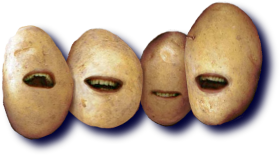

After more than a week, I've finally finished the first page of Karen's Laurel "scroll". It's written in late 15th-century Italian, and illuminated in the style of the Visconti Hours. My neck, back and hands are killing me, and I'm a little tired, but I'm quite pleased with the results.
It's the most ambitious piece of calligraphy I've done to date — four pages with lavish painting and goldleafing — but now that I've gotten into the rhythm, I think the other three pages should go faster. Especially the second one, which will have animals and such in the borders, and not so much of the exacting geometric lines and goldleafing.
(Goldleafing is probably the longest part of the process — first, lay down the pattern in gesso; then when that's dry, put down the size; wait one to three hours and put on the gold in little pieces; burnish it down and brush away the excess. Then, frequently, outline it all in black ink.)
My interest in the art of calligraphy started as a rebellion. Back when I was in fourth or fifth grade, my parents and I were told by a neurologist that I'd never be able to do anything requiring precise manual work, due to a fine-motor coordination deficiency. When I saw a Speedball Textbook later that summer, I wanted to try it. My parents reminded me of what the doctor said, and told me I probably wouldn't be able to do it, but that only strengthened my resolve. Throughout middle and high school, I took class notes in blackletter with a calligraphic fountain pen.1 Sadly, it was far more legible than my regular handwriting.
Calligraphy causes tremendous pain in my hands and fingers, but I refuse to let it beat me. Illumination isn't nearly as painful — fortunately for me, since it takes the lion's share of the time.
1 When I wasn't taking notes in non-Latin alphabets, that is. During the first marking period of my high school freshman algebra class, I kept my class notes in Norse runes, unaware that we would have to hand in our notebooks and be graded on their contents. I got an F on them, even though I could demonstrate to the teacher that I could read my own notes and that they did in fact contain what she had taught. So I kept the next marking period's notes in one of Tolkien's Elvish scripts. I am nothing if not stubborn.
The public school system was really not equipped to handle your uniqueness and intelligence.
And perhaps the "extended recovery period" could be used to come up with that text, eh?